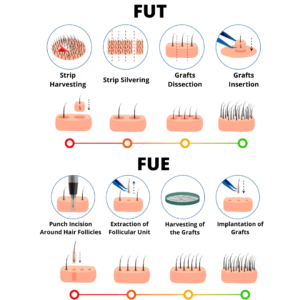- info@maxhaircenter.com
- +90 507 138 03 03
Hair transplant surgery procedures have gone a long way from the early days of hair transplants. Even so, scarring is still an expected result of the operation.
There are two sorts of surgical methods that are extensively employed nowadays. Each one generates a particular sort of scarring. The degree of scarring you get is mostly determined by the competence and experience of your surgeon.
Whichever you select, know that wound-closure methods have improved, along with the surgeries themselves.
Several variables will influence your method of choice, including:
The kind of scarring to be expected, the pattern of hair loss, the quantity and quality of donor hair, and the size of the thinning region.
Another consideration is the price. The optimum technique for you will be determined by you and your doctor together.
Removing hair after transplantation: the steps involved
The two surgical methods most typically used for hair transplant are follicular unit extraction (FUE) and follicular unit transplantation (FUT)
Both operations begin to induce obvious hair growth within three to six months.
FUE
This method employs hair follicles taken from the back and sides of the scalp (the donor regions) (the donor areas). Your surgeon will remove each hair follicle transplant separately with a micro-punch instrument. Each extraction creates a little circular scar, up to 1 millimeter in diameter.
Numerous puncture scars might be left behind depending on how many hair follicles are removed. These scars may seem like little white spots after healing. Each follicle has one to four hairs.
The hairs are then grafted onto the recipient portions of the scalp, where tiny incisions have been created for each individual hair. Given the meticulous nature of this technique, many hours — or even days — may be necessary for surgery.
The process may potentially be repeated multiple times over the course of two or three months to acquire the optimal effect.
FUE is done on an outpatient basis, under local anaesthetic. No sutures are required and recuperation time is often brief.
FUT
This treatment entails the surgical excision of a strip of scalp that includes hair from the donor location. This is often placed on the back of the scalp.
Once the hair strip has been removed, the region is sutured together.
Depending on the extent of the strip removed, this produces a linear scar that might vary in length. This scar may go from ear to ear in certain cases.
The hair follicle grafts are extracted from the scalp strip and ready for grafting onto the recipient portions of the scalp, where tiny incisions have been created for each individual hair.
This outpatient treatment also makes use of local anesthetic. The stiches are removed around 10 days later.
The FUT treatment may create greater discomfort and edema than the FUE process. Results vary from person to person.
Scar healing after hair transplantation
Several treatments may be utilized to minimize or diminish the size of the scar generated via the FUT process. Even if they succeed, they will almost certainly be left with some scars.
Remember that as you become older, your hair will naturally begin to droop. This might make the scalp reduction scar bigger or more apparent.
Another alternative would be to transplant hair follicles into the FUT scar using the FUE procedure. The success of this approach will be influenced, in part, by the thickness of the scar.
Scar tissue may be thinned with medicine, making this more feasible in certain situations.
This may not always hold true for grafts implanted into scarred skin. Your doctor will be able to tell you whether this surgery could work for you.
What are the best methods for hiding scars?
Another alternative is to conceal the scar using cosmetics. This may be achievable by growing your hair over the donor region.
Certain forms of scars, such as keloid scars, may be tougher to hide than others. Raised scars, called keloids, often outgrow the surgical scar site.
Keloid scars may continue to form over months, or even years. Keloid scarring may be a problem for certain individuals.
Let your doctor know if you’ve ever had a keloid scar before you undertake any form of hair transplant operation.
There are various treatments that might assist to hide your scar:
An injection of pigment straight into the scalp creates the illusion of thicker hair using scalp micropigmentation (SMP), which is also known as medical hairline tattooing or scalp tattooing. Surgery for hair transplantation is an option for certain individuals, but SMP is also an option.
This treatment may also be utilized to color in the damaged regions left behind by FUE or FUT.
Depending on the size of the injection region, it may take multiple sessions to finish the procedure. The ink color is selected to match your existing hair color. Even if your hair may become gray or lighter over time, the tattoo on your body will most likely not do so.
Some pain may be felt throughout this operation.
Tricopigmentation (TMP)
TMP is a temporary version of SMP. This process produces semi-permanent inking, since it introduces the ink into the top layer of the dermis.
The amount of time that inking from TMP lasts might vary from clinic to clinic, anything from six months to three years.
This technique may also be physically painful for some individuals.
Laser therapy
This therapy may help minimize the look of scars and is often used in combination with SMP or TMP. The laser targets and eliminates the damaged skin on the surface of the scar.
It also helps promote collagen formation in the skin’s dermis layer, renewing the elasticity and overall look of the skin.
Because it wasn’t created with hair transplant scar removal in mind, individual outcomes may vary.
The takeaway
Having a full head of hair again may be as simple as undergoing hair transplant surgery for many individuals. This may go a long way toward restoring confidence and self-esteem.
However, scarring is an unavoidable outcome of both the FUE and FUT surgeries. The FUE surgery may create a less obvious kind of scarring and may be a better match for certain individuals.
Choosing a skilled, experienced surgeon prior to undertaking any sort of operation is crucial.
It’s also conceivable that scars may be reduced to some scar. Covering the damaged region aesthetically or with permanent or temporary tattooing may also be an option.
If scarring makes this operation a nonstarter for you, speak to your doctor to learn about a body hair transplant (BHT) treat
